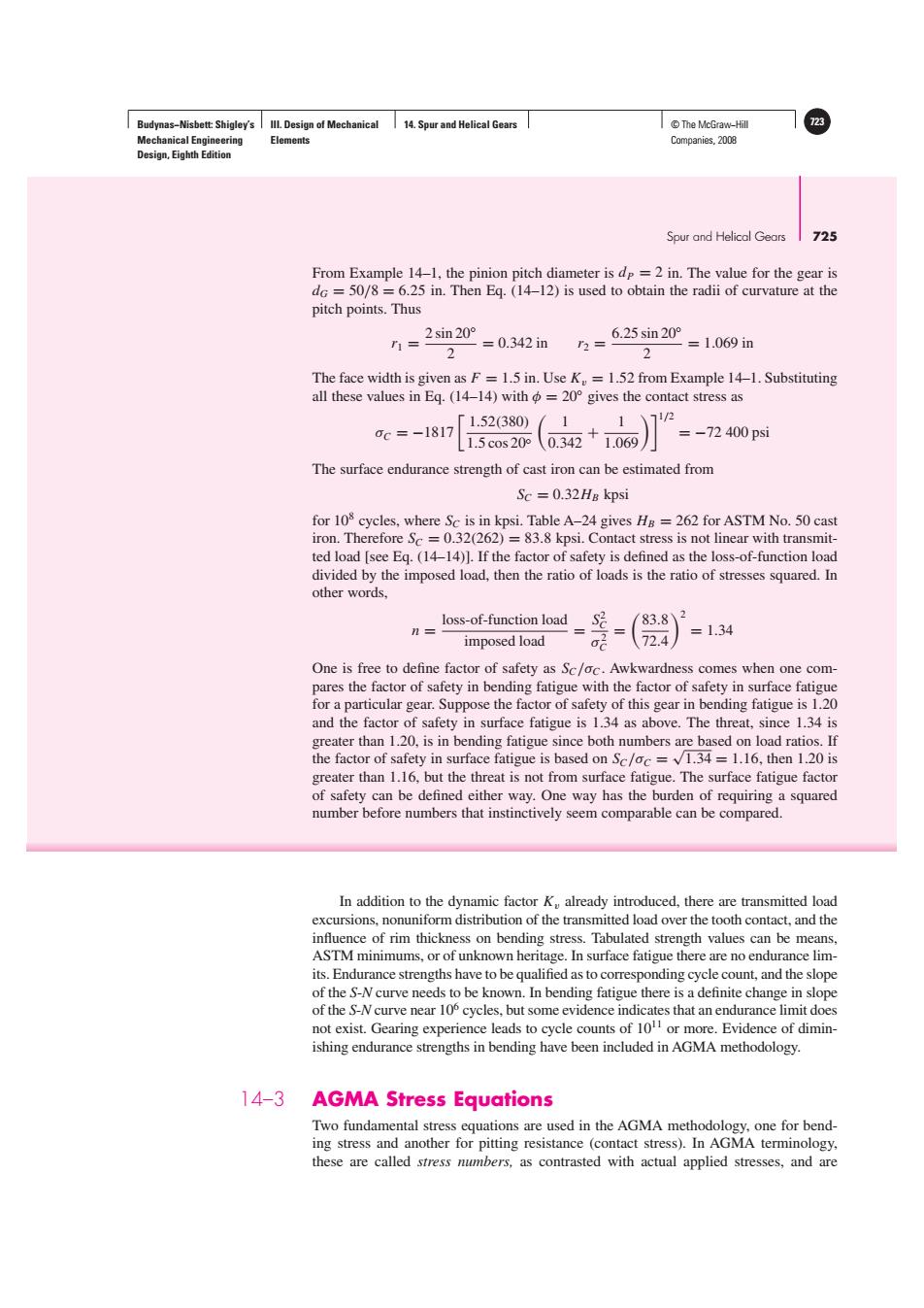正在加载图片...

Budynas-Nisbett:Shigley's Ill.Design of Mechanical 14.Spur and Helical Gears I©The McGraw-Hil 728 Mechanical Engineering Elements Companies,2008 Design,Eighth Edition Spur and Helical Gears 725 From Example 14-1,the pinion pitch diameter is de =2 in.The value for the gear is dg =50/8=6.25 in.Then Eg.(14-12)is used to obtain the radii of curvature at the pitch points.Thus 2sin20=0.342inn= 6.25sin20° i= 2 2 =1.069in The face width is given as F=1.5 in.Use K=1.52 from Example 14-1.Substituting all these values in Eq.(14-14)with=20 gives the contact stress as 1 1 0c=-1817 1.52(380) ((0.342+1.069月 =-72400psi 1.5 cos 200 The surface endurance strength of cast iron can be estimated from Sc =0.32Hg kpsi for 108 cycles,where Sc is in kpsi.Table A-24 gives Hg =262 for ASTM No.50 cast iron.Therefore Sc 0.32(262)=83.8 kpsi.Contact stress is not linear with transmit- ted load [see Eq.(14-14)].If the factor of safety is defined as the loss-of-function load divided by the imposed load,then the ratio of loads is the ratio of stresses squared.In other words. nloss-of-function load 83.8 2 =1.34 imposed load 0 72.4 One is free to define factor of safety as Sc/oc.Awkwardness comes when one com- pares the factor of safety in bending fatigue with the factor of safety in surface fatigue for a particular gear.Suppose the factor of safety of this gear in bending fatigue is 1.20 and the factor of safety in surface fatigue is 1.34 as above.The threat,since 1.34 is greater than 1.20,is in bending fatigue since both numbers are based on load ratios.If the factor of safety in surface fatigue is based on Sc/oc =v1.34=1.16,then 1.20 is greater than 1.16,but the threat is not from surface fatigue.The surface fatigue factor of safety can be defined either way.One way has the burden of requiring a squared number before numbers that instinctively seem comparable can be compared. In addition to the dynamic factor K,already introduced,there are transmitted load excursions,nonuniform distribution of the transmitted load over the tooth contact,and the influence of rim thickness on bending stress.Tabulated strength values can be means, ASTM minimums,or of unknown heritage.In surface fatigue there are no endurance lim- its.Endurance strengths have to be qualified as to corresponding cycle count,and the slope of the S-N curve needs to be known.In bending fatigue there is a definite change in slope of the S-N curve near 10 cycles,but some evidence indicates that an endurance limit does not exist.Gearing experience leads to cycle counts of 101 or more.Evidence of dimin- ishing endurance strengths in bending have been included in AGMA methodology. 14-3 AGMA Stress Equations Two fundamental stress equations are used in the AGMA methodology,one for bend- ing stress and another for pitting resistance(contact stress).In AGMA terminology, these are called stress numbers,as contrasted with actual applied stresses,and areBudynas−Nisbett: Shigley’s Mechanical Engineering Design, Eighth Edition III. Design of Mechanical Elements 14. Spur and Helical Gears © The McGraw−Hill 723 Companies, 2008 Spur and Helical Gears 725 From Example 14–1, the pinion pitch diameter is dP = 2 in. The value for the gear is dG = 50/8 = 6.25 in. Then Eq. (14–12) is used to obtain the radii of curvature at the pitch points. Thus r1 = 2 sin 20◦ 2 = 0.342 in r2 = 6.25 sin 20◦ 2 = 1.069 in The face width is given as F = 1.5 in. Use Kv = 1.52 from Example 14–1. Substituting all these values in Eq. (14–14) with φ = 20◦ gives the contact stress as σC = −1817 1.52(380) 1.5 cos 20◦ 1 0.342 + 1 1.0691/2 = −72 400 psi The surface endurance strength of cast iron can be estimated from SC = 0.32HB kpsi for 108 cycles, where SC is in kpsi. Table A–24 gives HB = 262 for ASTM No. 50 cast iron. Therefore SC = 0.32(262) = 83.8 kpsi. Contact stress is not linear with transmitted load [see Eq. (14–14)]. If the factor of safety is defined as the loss-of-function load divided by the imposed load, then the ratio of loads is the ratio of stresses squared. In other words, n = loss-of-function load imposed load = S2 C σ2 C = 83.8 72.4 2 = 1.34 One is free to define factor of safety as SC/σC . Awkwardness comes when one compares the factor of safety in bending fatigue with the factor of safety in surface fatigue for a particular gear. Suppose the factor of safety of this gear in bending fatigue is 1.20 and the factor of safety in surface fatigue is 1.34 as above. The threat, since 1.34 is greater than 1.20, is in bending fatigue since both numbers are based on load ratios. If the factor of safety in surface fatigue is based on SC/σC = √1.34 = 1.16, then 1.20 is greater than 1.16, but the threat is not from surface fatigue. The surface fatigue factor of safety can be defined either way. One way has the burden of requiring a squared number before numbers that instinctively seem comparable can be compared. In addition to the dynamic factor Kv already introduced, there are transmitted load excursions, nonuniform distribution of the transmitted load over the tooth contact, and the influence of rim thickness on bending stress. Tabulated strength values can be means, ASTM minimums, or of unknown heritage. In surface fatigue there are no endurance limits. Endurance strengths have to be qualified as to corresponding cycle count, and the slope of the S-N curve needs to be known. In bending fatigue there is a definite change in slope of the S-N curve near 106 cycles, but some evidence indicates that an endurance limit does not exist. Gearing experience leads to cycle counts of 1011 or more. Evidence of diminishing endurance strengths in bending have been included in AGMA methodology. 14–3 AGMA Stress Equations Two fundamental stress equations are used in the AGMA methodology, one for bending stress and another for pitting resistance (contact stress). In AGMA terminology, these are called stress numbers, as contrasted with actual applied stresses, and are